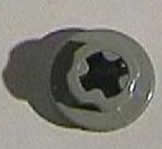|
|

Standard Pulleys
Pulleys are the complete opposite of gears in nearly every respect, apart from
the fact that they are used to transfer power across a distance. There are four
main types of pulleys, you can see them below:
 |
The pulley is more frequently used as a half bushing, but in this
case it can be used as a pulley. It has a relative size of 2.
|
 |
The friction gear has a special flexible plastic section inside
it to allow for better grip. It's relative size is 3.
|
 |
This is the medium sized pulley, and has six holes to allow peg
connections. It's relative size is 7.
|
 |
Finally, the large pulley has a relative size of 11. It is often
used as a large steering wheel.
|
 |
In much the same way that gears can reduce and increase power,
so can pulleys.
In this model, by turning the handle of the larger pulley, you
can see that the smaller pulley moves around 3.5 times quicker. This figure is
not exact, however, as you must always allow for slippage.
|
 |
This example works the other way, with the friction pulley turning
about 1.5 times slower.
|
There are three major differences between pulleys and gears.
• Pulleys keep the direction of the axle rotation the same.
• Pulleys transfer power using a rubber band.
• Pulleys cannot be relied upon for exact power ratios
(due to slippage).
|

